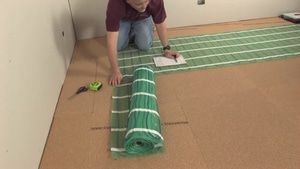
Cork Underlayment Support
Common Support Questions
How many square feet of floor heating can be connected to one thermostat?
One thermostat can control multiple heating mats/cables as long as all the heating elements are using less than 15 amps:
TempZone™ will cover aprx. 120 sq. ft. for 120V systems and 240 sq. ft. for 240V systems on one thermostat.
Environ™ will cover aprx. 150 sq. ft. for 120V systems and 300 sq. ft. for 240V systems on one thermostat.
Slab Heat will cover aprx. 90 sq. ft. for 120V systems and 180 sq. ft. for 240V systems on one thermostat.
Need more help? View support options
What is ThermalSheet Insulating Underlayment and how does it compare to cork?
ThermalSheet Insulating Underlayment is a synthetic cork, a lightweight thermal barrier made of hemi-crystalline thermoplastic.
WarmlyYours recommends ThermalSheet underlayment when installing a floor heating system over a concrete slab to prevent heat loss and protect against moisture. It will not rot, support mold and mildew, or absorb moisture.
- ThermalSheet synthetic cork underlayment (6mm) has a 1.5 R-value, crack isolation up to 1/4“, reduces sound by up to 22 dB, and is Robinson tested (TCNA) and rated for residential loads.
- Cork (6mm) has a .72 R-value, crack isolation up to 1/32“, reduces sound by up to 23 dB, and is Robinson tested (TCNA) and rated for residential loads.
Need more help? View support options
Can I pour self leveling cement over ThermalSheet underlayment?
Yes, unlike natural cork, ThermalSheet will not expand from self leveling cement (SLC).
Need more help? View support options
Is installing reflective insulation effective for making an electric radiant floor heating or snow-melting system more efficient?
Reflective insulation is not effective with conductive heating, which is how embedded floor heating and snow-melting systems transfer heat. To be effective, the reflective insulation surface needs to face an air space (air gap), which allows the reflected heat to be redirected.
An effective solution considers the insulating material's R-Value. This is the rating of a material's insulating properties. The "R" stands for "resistance" and refers to the material's resistance to heat flow, or temperature conduction.
Need more help? View support options
Publications and Manuals
Videos
Product Line Videos
